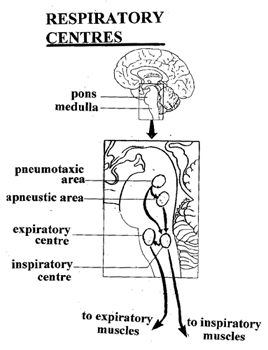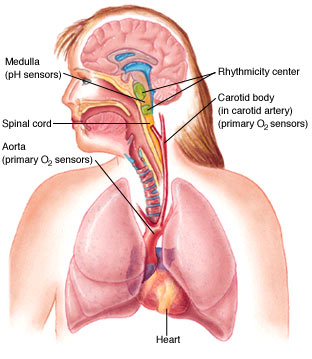General Control of Breathing:

Resipratory Centers
Your respiratory rate changes. When active, for example, your respiratory rate goes up; when less active, or sleeping, the rate goes down. Also, even though the respiratory muscles are voluntary, you can’t consciously control them when you’re sleeping. So, how is respiratory rate altered & how is respiration controlled when you’re not consciously thinking about respiration?
The rhythmicity center of the medulla in the brain-stem:
- controls automatic breathing
- consists of interacting neurons that fire either during inspiration (I neurons) or expiration (E neurons)
- I neurons – stimulate neurons that innervate respiratory muscles (to bring about inspiration)
- E neurons – inhibit I neurons (to ‘shut down’ the I neurons & bring about expiration)
Apneustic center (located in the pons) – stimulate I neurons (to promote inspiration) Pneumotaxic center (also located in the pons) – inhibits apneustic center & inhibits inspiration.

Breathing Control
General Control of Breathing:
Breathing is controlled by the medulla of the brainstem. It repeatedly triggers contraction of the diaphragm initiating inspiration. The rate of breathing changes with activity level in response to carbon dioxide levels, and to a lesser extent, oxygen levels, in the blood. Carbon dioxide lowers the pH of the blood.
There are control centers for respiration in both the medulla and the pons of the hindbrain.
There are chemosensors in the carotid artery and the arch of the aorta . The sensors of the aortal are sensitive to the level of oxygen in the blood. Sensors near the medulla are sensitive to the level of carbon dioxide in the blood. If oxygen level falls or carbon dioxide levels vary too greatly from the set point, a negative feedback mechanism increases respiratory rate. This brings in more oxygen and expels more carbon dioxide. Mammals are most sensitive to carbon dioxide levels because the amount of carbon dioxide varies most in respiration in response to different metabolic and environmental conditions.